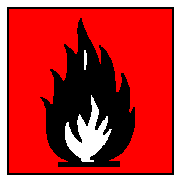International Chemical Safety Cards
| METHACRYLONITRILE | ICSC: 0652 |
| METHACRYLONITRILE Methylacrylonitrile 2-Methyl-2-propenenitrile 2-Cyanopropene Isopropenylnitrile C4H5N Molecular mass: 67.1 CAS # 126-98-7 RTECS # UD1400000 ICSC # 0652 UN # 3079 (Inhibited) EC # 608-010-00-2 |
 |
 |
| TYPES OF HAZARD/ EXPOSURE |
ACUTE HAZARDS/ SYMPTOMS |
PREVENTION | FIRST AID/ FIRE FIGHTING |
| FIRE | Highly flammable. Gives
off irritating or toxic fumes (or gases) in a fire. |
NO open flames, NO sparks,
and NO smoking. |
Powder, alcohol-resistant
foam, water spray, carbon dioxide. |
| EXPLOSION | Vapour/air mixtures are
explosive. |
Closed system, ventilation,
explosion-proof electrical equipment and lighting. |
In case of fire: keep
drums, etc., cool by spraying with water. |
| EXPOSURE | |
STRICT HYGIENE! |
|
| INHALATION | Headache. Weakness. Nausea.
Vomiting. Diarrhoea. Asphyxia. |
Ventilation, local exhaust,
or breathing protection. |
Fresh air, rest. Artificial
respiration if indicated. Refer for medical attention. |
| SKIN | MAY BE ABSORBED! (Further
see Inhalation). |
Protective gloves.
Protective clothing. |
Remove contaminated
clothes. Rinse skin with plenty of water or shower. Refer for medical attention. |
| EYES | Redness. Pain. |
Face shield, or eye
protection in combination with breathing protection. |
First rinse with plenty of
water for several minutes (remove contact lenses if easily possible), then take to a
doctor. |
| INGESTION | (Further see Inhalation). |
Do not eat, drink, or smoke
during work. |
Give a slurry of activated
charcoal in water to drink. Refer for medical attention. |
| SPILLAGE DISPOSAL | STORAGE | PACKAGING & LABELLING | ||
| Collect leaking and spilled
liquid in sealable containers as far as possible. Absorb remaining liquid in sand or
inert absorbent and remove to safe place. Do NOT let this chemical enter the environment
(extra personal protection: P2 filter respirator for harmful particles). |
Fireproof. Separated from
food and feedstuffs. Cool. Store only if stabilized. |
Do not transport with food
and feedstuffs. F symbol T symbol R: 11-23/24/25-43 S: (1/2-)9-16-18-29-45 Note: D UN Classification. UN Hazard Class: 3 UN Subsidiary Risks: 6.1 UN Packing Group: I Marine pollutant. |
||
| SEE IMPORTANT INFORMATION ON BACK | ||||
|
||||